Licenses
When an independent inventor applies for a patent, he is faced with a very limited range of possibilities:
o Either he manufactures his invention himself by creating his own company
o Or he looks for a manufacturer interested in manufacturing the patent, to which he grants an exploitation license, for, naturally, a financial compensation
o Last possibility : he waits for a miracle / business angel which, nowadays, are few and far between
In 1984, Bruno and Dominique Legaignoux, resolutely inventors, do not want to change themselves into manufacturers. Not either believing in miracles, they thus prefer the option of searching for a Licensee, and this, a few months only after the application of their first patent.
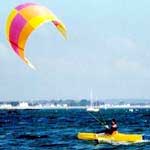
To draw the attention of the public, the media and possible manufacturers, to their invention, they take part in highly publicised and media magnet speed sailing competitions. In spite of promising results, they are forced to recognise that they are much too early with their idea, notably because the windsurfing market is rapidly expanding and thats what people are interested in.
One of numerous applications of the inflatable wing: The towed boat.
Furthermore, their invention is not really ready yet for mass production.
During the following years, while looking constantly for licensees, they perfect their kite and take advantage of it to investigate its numerous potential applications.
Finally, in 1993, not having been able to reach agreement with any manufacturer, the Legaignoux brothers create their own company: Wipicat. Ostensibly it is there to promote and publicise their invention and demonstrate to manufacturers that a market exists for that kind of nautical application.
Manufacturing in France turns out to be very expensive and commercial success is still not completely assured. On the other hand, fruitful overseas contacts are made and, from 1996, production is organized in Asia, under the brand Wipika.
Wipika becomes, in doing so, the first official licensee of the Legaignoux brothers patent.
Being a concessionary of a license is, in a sense, "to rent" the right to use, to financially exploit, a patented invention. A license can be limited, notably in time and in space. It can be exclusive or not. In recognition of this right, the licensee pays royalties to the owner of the patent.
The story speeds up...
In 1998, in the Hawaiian Islands, theres big excitement in the small circle of windsurf pioneers : a promising new toy has just appeared. The Naish Sails company pays particular attention and gets in touch with Bruno Legaignoux.
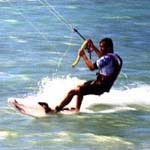
Long discussions proceed and, in due course, an agreement is reached and Naish becomes the second licensee of the Legaignoux brothers. In September, 1999 Naish Kites launches and markets its first range wings.
After Naish, numerous companies wanted to join the two licensees, but a stiff selection policy is instituted by the holders of the patent to keep the nascent market healthy and profitable for the licensees.
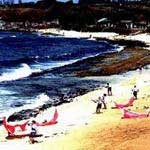
The mythical Ho'okipa was one of the first beach hited by the kitesurf phenomenon in Maui-Hawaii.
Why acquire a license ?
Any ambitious company has to be interested in obtaining a license. A license allows a company to work on a tested concept, to quickly take a position in the market, without risk of pursuit from the patent holders. It also allows a company to benefit from the manufacturing technology finalised by the Legaignoux brothers and of their considerable experience in the important area of safety.
The list of Licensees of the "Propulsive wing with inflatable structure" patent
WIPIKA till 2001, then an infringer,
NAISH, CABRINHA, SLINGSHOT, NORTH, FLEXIFOIL, AIRUSH, GAASTRA, TAKOON
ALL OTHER BRANDS WERE COUNTER-FEITERS till November 8th, 2005, end date of the patent.
However it should be noted that the Legaignoux patent on the 4-line kite patent and its control bar, applied for in 1997 in France, is still running.
Any 4-line kite sold in France until 2017 must thus be subject to payment of royalties. Infringers will be prosecuted.
Bow License
The price of the license is Euros 12 (about US$15) per manufactured kite. In counterpart the Licensee receives the certificates and the Know-How corresponding to the patent.
This cost thus has only a negligible influence on the final price of a kite.
Here are two banners for the use of our Licensees.
Some customers and retailers are sensitive to the respect of the patent rights. Licensees, let them know that you respect them.
 |
<a href="http://www.inflatablekite.com" target="_blank"> <img src="http://www.inflatablekite.com/sitebow/dessins/banniere3.gif" alt="Bow kite patent licensee !" height="60" width="330" align="middle" /> </a> |
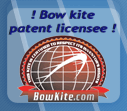 |
<a href="http://www.inflatablekite.com" target="_blank"> <img src="http://www.inflatablekite.com/sitebow/dessins/banniere4.gif" alt="Bow kite patent licensee !" height="111" width="127" align="middle" /> </a> |
And here are two banners for all the owners of Internet sites relating to kite who wish to support our work and who find abnormal that certain brands do not take a licence. Thanks for your assistance!
 |
<a href="http://www.inflatablekite.com" target="_blank"> <img src="http://www.inflatablekite.com/sitebow/dessins/banniere1.jpg" alt="BowKite.com : Kite innovation since 1984" height="60" width="330" align="middle" /> </a> |
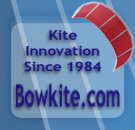 |
<a href="http://www.inflatablekite.com" target="_blank"> <img src="http://www.inflatablekite.com/sitebow/dessins/banniere2.jpg" alt="BowKite.com : Kite innovation since 1984" height="130" width="135" align="middle" /> </a> |
The list of Licensees of the BOW patents